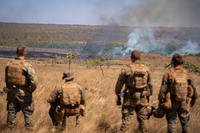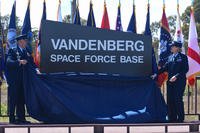CAMP ATTERBURY JOINT MANEUVER TRAINING CENTER, Ind. -- At an entry control point, Spc. Ashley Craig, an in-home care specialist from Louisville, Ky., looked through the gate as local contractors arrived to report for work. Craig, charged with determining who would be allowed inside the gates, called on all the skills she had only recently learned during mobilization training.
National Guard Soldiers from Kentucky preparing to deploy to Djibouti as Task Force Longrifle gained a sense of the challenges they will soon face when they participated in the realistic training exercise. Developed by the 205th Infantry Brigade at Camp Atterbury Joint Maneuvering Center, Ind., the exercise was designed to help Craig and other members of the 2/138th Field Artillery Battalion, Lexington, Ky., test the procedures they had learned but also reinforced their confidence as they prepared to deploy.
"The First Army team has given us tips on how to man the [entry control point]," said Craig, one of 565 Soldiers deploying to the Horn of Africa from the Kentucky National Guard.
The realistic training give her confidence that she will be prepared to keep her fellow Soldiers secure when she arrives in country, she said.
Pfc. Ismaila Pam, a student at Spalding University in Louisville, Ky., and Task Force Longrifle teammate, agreed.
"It's a view of what it's going to be like," said Pam, who emigrated from West Africa. "So, we can be more confident of how it will be when we get down there."
This will be the first deployment for two-thirds of the Task Force Soldiers, including Craig and Pam.
Sgt. 1st Class Scott Richardson, 205th Inf. Bde., the scenario developer, spent nine days on a pre-deployment site survey, or PDSS, in Djibouti doing research prior to the Kentucky Soldiers' arrival.
"I spend one day at each of the mission sets talking to the guys to see what they do," Richardson said. "It's a permission environment over there; it's not like Iraq and Afghanistan."
Conducting the PDSS is just one way that First Army Division East ensures they tailor training to each deploying unit's misson.
The scenarios covered the loss of sensitive items, a vehicle breaking down at the entry control point, movement of local contractors who work on the base, a media engagement, and other issues.
Richardson said the scenarios were meant to help prepare the Soldiers for the repetitive nature of their upcoming deployment.
One of the scenarios tested the Soldiers of Task Force Longrifle, 2/138th Field Artillery Battalion, Lexington, Ky., knowledge of command messages and ability to interact with reporters.
Brigade public affairs officers Maj. Penny Zamora and Staff Sgt. Reginald Graddy portrayed reporters trying to get information.
Sgt. 1st Class Wesley Averkamp, an observer, trainer with the 1-335th Infantry Regiment, 205th Infantry Brigade, watched as the National Guard Soldiers kept the reporters at a safe distance. Averkamp, there to help mentor the unit and make on the spot corrections during the scenario, spoke with one of the Soldiers.
After nearly 10 minutes of the reporters constant questions and comments, 1st Lt. Andrew VonHandorf, gave the name and number of the Task Force Longrifle's public affairs officer to the reporters. VonHandorf was later told he had reacted correctly; however, for these younger Soldiers, not only was this their first interaction with members of the media as Soldiers, it was their first mobilization and deployment.
Staff Sgt. Steve Tressler, public affairs professional with the Task Force, said the Soldiers are ready for the deployment to begin. The public affairs office has developed command messages and a "Troop Card" for Soldiers.
"If you can develop public affairs guidance that the lowest ranking Soldier can understand and discuss the mission and what they are doing and why, it becomes a very powerful tool," said Col. John F. Dunleavy, commander of the 205th Infantry Brigade, First Army Division East. "Everyone expects senior leaders to speak to the media, but when Pfc. Jones can articulate why they are there and what they are doing it's a powerful thing."
Last year, First Army Division East trained more than 19,000 Soldiers for deployment to places like Afghanistan, Iraq, Kosovo, the Sinai Peninsula, and the Horn of Africa.
"It's going to be a life changing experience," said Spc. DeMarcus Hopson, a student at Kentucky State, Ky., the noncommissioned officer in charge of the Entry Control Point during a training scenario.
DeMarcus, who is studying secondary education, smiled and laughed a little before continuing.
"I've always wanted to go to Africa, I guess I get to go for free now," Hopson said.
DeMarcus said the 205th Infantry Brigade has helped his Soldiers understand how to maintain positive control of the entry point.
"The Soldiers who just returned from Djibouti helped enforce the training we've received here and gave us a better understanding of what the job entails," he added speaking of Richardson's site survey.
It's part of meeting today's challenges and tomorrow's uncertain conflicts, said Dunleavy.
"We must field an Army that can rapidly dominate any operational environment and provide decisive results across a full range of missions that include deterring and defeating aggression, providing humanitarian assistance, and engaging with our allies while building partner capacity which is what these Soldiers will be doing in the Horn of Africa," Dunleavy explained.


























